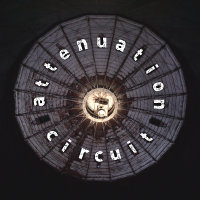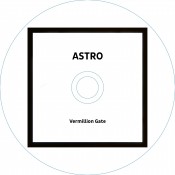Vermillion Gate
by ASTRO
The Rollator Series on attenuation circuit, dedicated to noise and curated by noise artist ORiFiCE, returns with a new release by Japanese noise duo Astro. Hiroshi Hasegawa on modular synth and Rohco on electric violin (!) and electronics offer an intense, immersive and atmospheric noise album.
The album features three tracks, with the first two clocking in at about 15 minutes each. Thanks to the use of a variety of textural materials, not only the instruments mentioned above but also field recordings and samples, Astro create the dense, deep mass of sound that is necessary to achieve a great physical noise experience, but also manage to keep it musically interesting because there are always little changes going on in the sonic texture.
The third track, “Vermillion Gate”, lasts almost half an hour and is a relentless climb towards a culmination point which – spoiler alert – could lead one to suspect that one's listening device has broken. If noise is the intentional dramatisation of losing control over acoustic signal chains in order to demonstrate the fragility of our addictive relationship to technology, then this is a masterpiece that goes all the way towards the complete collapse of the system it has set up.
File under: noise
1015
factory-produced CDr in cardboard sleeve
Released in 2020
limited to 100 copies
price: 7.00 EUR (excl. postage)
Rollator Series ACRS 1015
recorded at several spaces between November 2019 and January 2020, mixed and mastered by Hiroshi Hasegawa at Koenji-Minami Studio Tokyo, February and March 2020.
Hiroshi Hasegawa (modular synth, field recordings and samplings)
and Rohco (electric violin and electronics)
coverartwork by DORIS BOEKER
design by EMERGE
www2.odn.ne.jp/astro/
cosmic-coincidence.tumblr.com
www.facebook.com/ASTRO-CCCC-Hiroshi-Hasegawa-139400716132299/
The Japanese noise unit ASTRO was founded in 1993.
Mastermind Hiroshi Hasegawa although founded and formed C.C.C.C. (a.k.a. Cosmic Coincidence Control Center), another well-known Japanoise outfit, in 1990.
It is very important for Hiroshi that listeners listen to his composition or details of his work carefully. He always feels noise is very fertile, that there are many opposite elements in it. Diversity and variousness are basic and crucial themes in this connection. Also one charm of noise is feeling both extreme images of destruction and creation in its background, he thinks.
Complete improvisation of free flow is elementary for live shows by ASTRO. Its style of playing seems like drifting between meditation and awaking …
Today ASTRO is a duo together with Rohco.
Also available here: http://www.discogs.com/seller/dependenz?sort=price&sort_order=asc&q=attenuation+circuit&st
NIEUWE NOTEN
Onder de naam ‘Rollator Series’ brengt het in Augsburg zetelende Attenuation Circuit noise uit, gecureerd door ORiFiCE. De laatste uitgave in deze serie is van het Japanse duo ASTRO, bestaande uit Hiroshi Hasegawa op de modulaire synthesizer en Rohco, het alias van Hiroko Hasegawa, op elektrische viool en elektronica. ‘Vermillion Gate’ heet het album met slechts drie stukken.
De wortels van Hiroshi Hasegawa in de noise liggen bij C.C.C.C., dat hij in 1989 begon samen met Mayuko Hino, Ryuichi Nagakubo en Fumio Kosakai. Deze groep, opgericht in 1989, geldt nog altijd als één van de belangrijkste in de Japanse noise scene. Nog tijdens zijn deelname aan C.C.C.C. startte hij in 1993 met zijn soloproject, ASTRO. Met ROHCO werkt hij voor het eerst in 2009, wat leidde tot het omvormen van ASTRO tot duo in 2013.
Zet ‘Asynchronous Waveform’ op en je weet direct hoe laat het is. Een stortvloed van puin en gruis stort het duo over je uit. De term ‘mooi’ is weer eens volstrekt misplaatst. Overweldigend, overheersend en onrustbarend zijn begrippen die beter passen. Ok, je moet ervan houden, maar dat geldt voor alle muziek en als je ervan houdt valt er veel te genieten. Want in die onrustbarende stortvloed zijn wel degelijk nuances te herkennen, het ene gruis is het andere niet. De twee draaien de knop na bijna vijftien minuten even uit om aansluitend in ‘True Seals’ weer op de ingeslagen weg verder te gaan. Bulldozers, drilboren en andere machines, associaties te over. Maar ‘True Seals’ kent uiteindelijk wat meer variatie: de continue stroom noise wordt hier aangelengd met futuristische klankgolven.
Voor het titelstuk, ‘Vermillion Gate’, trekt het duo bijna een half uur uit en gaan de sluizen nog een fractie verder open. Nog steeds noise, maar nu zit er meer verschil in de dynamiek en het tempo. Slepende inktzwarte klankwolken, snerpende cirkelzagen, golven massief gruis, of de aarde in beweging komt. En steeds als je denkt dat het summum nu wel bereikt is, blijk je je weer vergist te hebben.
https://www.nieuwenoten.nl/?p=9553
BAD ALCHEMY
ASTRO stammt selber aus dem "Black Bloody Cosmos". Als "Cosmic Cannibal", als "Cosmic Radiation", als Alien. Seit 30 Jahren spielt Hiroshi Hasegawa mit dem kosmischen Vektor, mit Cosmic Coincidence Control Center (C.C.C.C.), Astral Travelling Unity, South Saturn Delta, Galax, Astromero und seit zehn Jahren im Verbund mit Hiroko 'Rohco' Hasegawa, er mit Modularsynthie, Feldaufnahmen und Samplings, sie mit E-Violine und Electronics. So jedenfalls bei Vermillion Gate (ACRS 1015), in dessen Zinnober „Die tausend Träume von Stellavista“ von J. G. Ballard mitschwingen, als 'Asynchronous Waveform'. Fragt mich nicht, wie die 'True Seals', die Hundsrobben, auch Earless Seals genannt, ins Spiel kommen. Wegen dem 'earless'? Das können nur Spötter vermuten und die sollten sich besser um ihre Sterblichkeit sorgen. Andererseits braucht es tatsächlich robuste Trommelfelle, um dem eisernen Kladderadatsch und rauschenden Tsunami standzuhalten, der da auf einen einstürzt. Als würde da wieder einmal Godzilla ein paar Metropolen kurz und klein trampeln bei einer Rauferei mit Mothra, King Ghidorah oder Kong, und ihr Hauen, Stechen und Fauchen das Meer zum Kochen bringen. Was für ein verstrahltes, zerblitztes Stahlgewitter und ätzendes, zischendes, überschäumendes Säurebad im großen „King of the Monsters“-Stil. Das absolute Endgegner-Armageddon!!! Nur dass Astro da statt dem schwülstigen Bombast von Bear McCreary die kakophonen Schleußen aufreißt und alle sieben Siegel öffnet. So dass der achte Engel der ganzen Erde sein Rauchfass um die Ohren schlägt, und die sieben dröhnenden Posaunenengel pusten die Brösel derart in die Auferstehung, dass Windstärke 17 daneben wie ein hingehauchtes Küsschen erscheint. Wenn der Krach schließlich abreißt, schlägt die Stille zu wie eine Guillotine.
http://badalchemy.de/
VITAL WEEKLY
Since many years Astro is the solo project of Hiroshi Hasegawa, who is also a member of CCCC. He plays modular synthesizer, field recording and sampler. Also part of Astro on this release is one Rohco who plays electric violin and electronics. Not that one could easily recognize field recordings or violins in the three pieces on this release; two pieces of about fifteen minutes and one that is twenty-nine. That one, the title piece, sees Astro being at his loudest. It is a long onslaught of distorted sounds, but it's not of the strict harsh noise variety. It almost sounds as if Astro first stuck a whole bunch sounds on tape, with hard cuts between them and then feeds it through his modular synth, with everything sets to overload and destroy. The two shorter pieces before that, by comparison, is a tad less destructive and upon re-listening, one can recognize the field recordings (which I guess were taped at a demolition site downtown). The violin is nowhere to be recognized and it could be about any instrument being fed through a whole lot of electronics, resulting in feedback and distortion. It all sounds very akin to Merzbow and should there not be enough of that, there is always Astro (luckily not on a similar release schedule frenzy).
http://www.vitalweekly.net/1236.html



 brezenstudio engine
brezenstudio engine